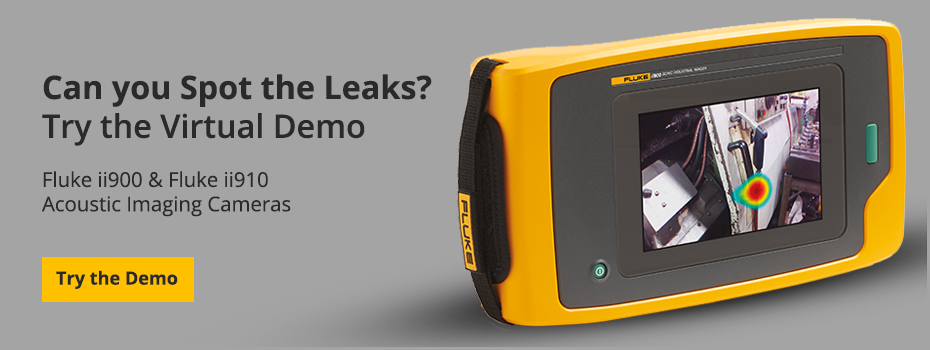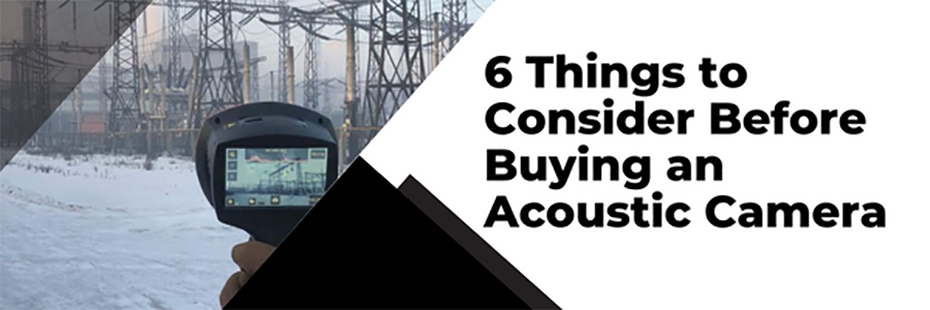 All facilities managers working in industrial plants know how time-consuming, money-draining, and frustrating it can be to find compressed air leaks or electrical faults such as partial discharge. Fluke knows this too. That’s why they’ve developed two simple-to-use sonic imagers. The Fluke ii900 and ii910 Acoustic Cameras detect ultrasonic noise and convert it into a sound map that is overlaid onto a digital image. This allows you or any member of your team, regardless of experience, to locate leaks or pinpoint partial discharge precisely. The advantages of the Fluke ii900 & ii910 Acoustic Imagers lie in their ease of operation: specialist training is not required; laborious tracing becomes a thing of the past; and production does not have to be halted. As a result, you maximise efficiency, minimise downtime, and save money.
Continue reading →
All facilities managers working in industrial plants know how time-consuming, money-draining, and frustrating it can be to find compressed air leaks or electrical faults such as partial discharge. Fluke knows this too. That’s why they’ve developed two simple-to-use sonic imagers. The Fluke ii900 and ii910 Acoustic Cameras detect ultrasonic noise and convert it into a sound map that is overlaid onto a digital image. This allows you or any member of your team, regardless of experience, to locate leaks or pinpoint partial discharge precisely. The advantages of the Fluke ii900 & ii910 Acoustic Imagers lie in their ease of operation: specialist training is not required; laborious tracing becomes a thing of the past; and production does not have to be halted. As a result, you maximise efficiency, minimise downtime, and save money.
Continue reading →sonic imaging
-
Familiarise Yourself with Fluke’s ii900 & ii910 Acoustic Imagers Using Fluke’s Virtual Demo
 All facilities managers working in industrial plants know how time-consuming, money-draining, and frustrating it can be to find compressed air leaks or electrical faults such as partial discharge. Fluke knows this too. That’s why they’ve developed two simple-to-use sonic imagers. The Fluke ii900 and ii910 Acoustic Cameras detect ultrasonic noise and convert it into a sound map that is overlaid onto a digital image. This allows you or any member of your team, regardless of experience, to locate leaks or pinpoint partial discharge precisely. The advantages of the Fluke ii900 & ii910 Acoustic Imagers lie in their ease of operation: specialist training is not required; laborious tracing becomes a thing of the past; and production does not have to be halted. As a result, you maximise efficiency, minimise downtime, and save money.
Continue reading →
All facilities managers working in industrial plants know how time-consuming, money-draining, and frustrating it can be to find compressed air leaks or electrical faults such as partial discharge. Fluke knows this too. That’s why they’ve developed two simple-to-use sonic imagers. The Fluke ii900 and ii910 Acoustic Cameras detect ultrasonic noise and convert it into a sound map that is overlaid onto a digital image. This allows you or any member of your team, regardless of experience, to locate leaks or pinpoint partial discharge precisely. The advantages of the Fluke ii900 & ii910 Acoustic Imagers lie in their ease of operation: specialist training is not required; laborious tracing becomes a thing of the past; and production does not have to be halted. As a result, you maximise efficiency, minimise downtime, and save money.
Continue reading → -
6 Things to Consider Before Buying an Acoustic Camera
 Acoustic imaging cameras, otherwise known as sonic or ultrasonic imagers, are popular amongst facilities managers, especially those working in industrial or high-voltage settings. They are extremely easy to use and highly effective at finding air/pressurised leaks and partial discharge/corona. Acoustic cameras detect audible and/or ultrasonic sound; convert it into a sound map; then superimpose this map onto a digital image of the inspection area, allowing you to pinpoint the source of the leak or electrical fault accurately, simply, and quickly. As sonic imaging is a relatively new preventative maintenance/inspection technology, it can be difficult to know what makes a good acoustic camera. Thankfully, Teledyne FLIR has outlined six things to look for when purchasing an ultrasonic imager.
Continue reading →
Acoustic imaging cameras, otherwise known as sonic or ultrasonic imagers, are popular amongst facilities managers, especially those working in industrial or high-voltage settings. They are extremely easy to use and highly effective at finding air/pressurised leaks and partial discharge/corona. Acoustic cameras detect audible and/or ultrasonic sound; convert it into a sound map; then superimpose this map onto a digital image of the inspection area, allowing you to pinpoint the source of the leak or electrical fault accurately, simply, and quickly. As sonic imaging is a relatively new preventative maintenance/inspection technology, it can be difficult to know what makes a good acoustic camera. Thankfully, Teledyne FLIR has outlined six things to look for when purchasing an ultrasonic imager.
Continue reading →
Page
Previous
Page 1 of 1
Page
Next


